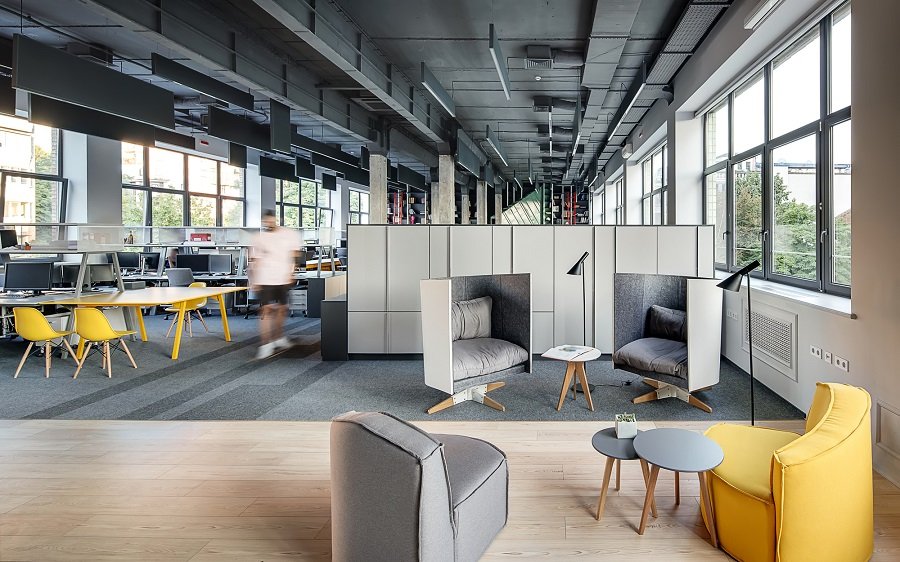Are you moving into a new office space? Are you wondering how you should design the floorplan?
Your office’s floorplan can have a huge impact on your company’s productivity, happiness, efficiency, and even safety. How do you design a space that works for everyone?

Check out this office space floor planning guide to discover how it’s done.
Open vs Closed Office Floor Plan
When laying out your floor plan for your office, you have two primary layouts to choose from: an open floor office plan or a closed floor office plan.
Traditional closed-floor office plans include private conference rooms and high-walled cubicles. Private offices are typically arranged along the exterior walls so that each one has a window. The benefits of a traditional closed-floor plan include:
- Increased privacy
- Limited noise and fewer distractions
- Improved employee concentration (in some cases)
With open floor office plans, high walls are ditched for low-walled cubicles, bench seating, and conference rooms with glass walls. Some of the benefits of closed office floor plans include:
- Boosts employee collaboration
- Reduces your real estate costs
- The layout can easily be modified
Open floor office plans are currently trending, and a lot of that has to do with the current commercial real estate market. Because more companies are opting for smaller spaces, they want an open floor plan that gives the office the illusion of a bigger size.
Consider How Your Office Runs
When deciding on an office floor plan, you also want to consider how your office runs. Here are some things you’ll want to ask yourself:
- How many departments will be housed in this space?
- How many current employees do we have?
- How much do we plan to expand in the next 5 to 10 years?
- How do people move through the space? (ie, what’s the foot traffic like?)
- Is there a need for ancillary spaces? (ie, bathrooms, conference rooms, phone rooms, huddle rooms, reception areas, workout areas, or storage space)
- Which employees interact on a daily basis and need to be near one another?
By asking yourself these questions, you’ll have a better understanding of how you need to lay out your office. Likely, you’ll find that a mix of private and collaborative spaces is best for your office.
Map Out Furniture Placement
Once you’ve answered the above questions, you can start mapping out your furniture placement.
But, before you plan how you’re going to arrange your furniture, figure out whether or not it’s a good idea to keep all of it. Chances are, you have some old furniture that isn’t ergonomically designed.
Poorly made furniture can increase your employees’ risk of developing health issues, such as back pain, neck pain, poor digestion, carpal tunnel. These issues can lead to poor sleep, anxiety, depression, and decreased productivity.
This is why it’s so important to invest in good furniture for your office. If you’re not sure which furniture you need to throw out, ask your employees. Chances are, they’ll have strong opinions about how comfortable the furniture really is.
Once you know what furniture you need to get rid of and which you intend to keep, you can make a few mockups of the layout. If you feel like furniture arrangement is way outside of your wheelhouse, consider hiring an interior designer for help.
Ideally, you want to strike a balance between aesthetic design and the needs of your business.
Figure Out Desk Placement
Once you’ve figured out where you’re going to put large pieces of furniture, it’s time to decide where you’re going to place everyone’s desks.
Again, when deciding on desk arrangements, think about which employees interact the most and need to be closest to one another. Once you have a general idea of where you want the desks and furniture to go, pitch your design to your staff. Hopefully, they’ll be able to provide you with feedback in terms of what they like and don’t like.
Consider Your Clients
When putting together your new office floor plan, you also need to consider your clients and customers. If you rarely have clients come into the office, then you don’t need to worry about this aspect too much.
But, if your office is frequently visited by clients, then you want to prioritize how they’ll see your office when walking in. If, for example, you’re designing a new dental office, you’ll want to make sure your dental office floor plan makes it easy for your patients to check-in.
You should put a lot of emphasis on the waiting room design, as this area gives patients their first impression of your office. You also want to think a lot about the aesthetic, as you’ll want your patients to feel comfortable and at-ease.
And, you’ll also want to make sure your office is easy to navigate for your patients. Your patients should have no trouble finding their way back to the front desk from their dental chair.
Of course, a dentist’s office is just one type of business, so you may have different considerations depending on the industry you work in.
Consider Your Technological Requirements
Last but not least, you’ll also want to consider your technological requirements when designing your new office floor plan.
The best way to figure out how to set up your office so it’s conducive to your technological needs is to speak the head of your IT department or the head of engineering. They should have a pretty good idea of how to arrange your space so everyone has easy access to the technology they need.
Office Space Floor Planning: Are You Ready to Plan?
Now that you’ve read this office space floor planning guide, it’s time to start planning for your new space. Pretty soon, you’ll be in a new office space that both you and your employees love.
Be sure to check back in with our blog for more office design tips and tricks.




